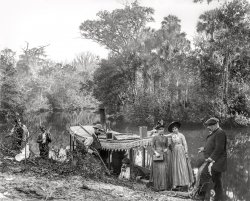
MAY CONTAIN NUTS

Search Shorpy
SHORPY ART

Framed or unframed, desk size to sofa size, printed by us in Arizona and Alabama since 2007. Explore now.
Join and Share
Ad-Free Shorpy
Shorpy is funded by you. Patreon contributors get an ad-free experience.
Learn more.

Recent comments
- Baldwin 62303
- Baldwin VO-1000
- Cold
- No expense spared
- Tough Guys
- Lost in Toyland
- And without gloves
- If I were a blindfolded time traveler
- Smoke Consumer Also Cooks
- Oh that stove!
- Possibly still there?
- What?!?
- $100 Reward
- Freeze Frame
- Texas Flyer wanted
- Just a Year Too Soon
- WWII -- Replacing men with women at the railroad crossing.
- Yes, Icing
- You kids drive me nuts!
- NOT An Easy Job
- I wonder
- Just add window boxes
- Icing Platform?
- Indiana Harbor Belt abides
- Freezing haze
- Corrections (for those who care)
- C&NW at Nelson
- Fallen Flags
- A dangerous job made worse
- Water Stop
Member Photos
The Shorpy
Print Emporium
Print Emporium
Search Shorpy
Search results -- 30 results per page
- Detroit Boat Club (Colorized)
- View from the Water - Detroit Boat Club, Belle Isle, Detroit, Mich. Circa 1905. Colorized photo from Library ... Posted by Dennis Klassen - 12/14/2011 - 2:00pm -
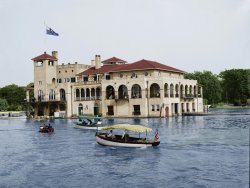
- Detroit Boat Club (Colorized): c. 1905
- Detroit Boat Club, Belle Isle, Michigan, circa 1905. Library of Congress, Detroit ... Posted by Dennis Klassen - 10/11/2011 - 8:05am -
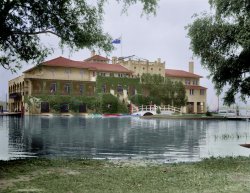
- Float in a Boat: 1961
- ... kid. I remember watching from the shore. Eventually the boat sank and was lost. The lake was big and deep. What a terribly dangerous ... Posted by mhallack - 05/04/2009 - 12:57pm -
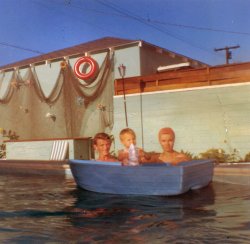
- Harpers Ferry: 1865
- ... Library of Congress. View full size.
Bridge and Boat That bridge is lovely! And it looks like there's a boat being drawn by horses in the canal on the left.
Harpers Ferry First ... Posted by Dave - 05/19/2008 - 11:37pm -
![Harpers Ferry: 1865 1865. "Harpers Ferry, West Virginia. View of Maryland Heights at confluence of Shenandoah and Potomac rivers." Wet plate glass negative (detail) by James Gardner. Civil War glass negative collection, Library of Congress. View full size.
Bridge and BoatThat bridge is lovely! And it looks like there's a boat being drawn by horses in the canal on the left.
Harpers FerryFirst saw a picture of Harpers Ferry in a 1950s National Geographic. Took the family to see it in 1958 and we climbed to the top of mountain where early pictures showed Union Troops. Now the National Park Service runs everything.
Maryland HeightsThis view looks downstream; the rocks on the far side are Maryland Heights. The bridge in the center is still represented by a line of piers adjacent to the present bridges.
Anniversary of the RaidNext year marks the 150th anniversary of the raid on Harpers Ferry. More info, including some very nice photos, here: http://www.harpersferryhistory.org/johnbrown/index.htm
Harpers FerryThey've done a lot of restoration in the town over the past few years. It's always breezy because of the two rivers, so even on the hottest days it's usually pleasant. Plenty to see and learn, and the restaurants provide rest and excellent provender! Beautiful spot that we revisit often.
Harpers Ferry BridgeThe bridge spans are some of the earliest examples of the Bollman truss, a hybrid truss/suspension design which originated on the B&O. The only surviving example is in Savage, Maryland.
Harpers Bridge Recent ViewsAnyone interested in "current" views? 1974 from very roughly same location:
and 12/6/07 opposite direction,
Bollman bridge piers remain in river at left, 1893 replacement bridge in center, 1930's replacement bridge at right as the railroad addressed the horrid original alignment here (look at those curves at span ends in the 1865 version).
The predecessors to the Bollman were blown up over and over again as the Civil War surged back and forth here.
Harpers FerryAnd Amtrak can take you right there on the spot. There's the train station on the west side of the rivers, which provides a great view as well. Amtrak train the Cardinal from NY to Chicago through Washington DC will take you there. It's a beautiful trip through the Adirondack mountains going west, been through there myself more than once.
Harpers Ferry TodayThe C&O Canal Towpath, a national park, follows the Potomac River from Cumberland, Maryland, to Georgetown (D.C.). That makes it a 185-mile park, and the stretch through Harpers Ferry is among the most beautiful parts. Strongly recommended for anyone who can walk, bicycle or roll for a mile or two.
[There's also a nice footpath through the woods to Maryland Heights -- the top of the cliff to the left. The view is spectacular. - Dave]
One of my favorite places on Earth!I can remember stopping there on my way back to live in Kansas after graduating from high school and college in Maryland. I foolishly stood in the middle of the street and stared across the river at the tunnel. A horn honked and I turned and saw a beautiful long-haired blonde driving a huge red convertible. The world seemed rife with possiblities at that moment in a way that was different from anything that followed in later years!
Harpers Ferry by TrainIt's the Amtrak Capital Limited, train No. 29 west, and 30 east. Of course before Amtrak this town was served by the Baltimore and Ohio Railroad, and the original Capital Limited.
That House!!Having visited Harper's Ferry several times, I started to search my photos to see if I had a modern comparable shot... but the thing that stood out most to me was that tiny white house on the left edge of the photo!! The structure is still there and people always stop to explore it!
There's also an old ad that seems to be painted into the side of the mountain, which I've never been able to figure out what it says... I see "powder"...
Last Trip TogetherMy husband Steve and his brother-in-law Jack visited Harpers Ferry in March of 1995. Steve, the shutterbug of the family, took along his camcorder and we have lots of footage. I've never been there and now, thanks to this photo, I'm going to "revisit" the area by viewing this footage again.
Steve and Jack will never know how poignant their vacation was. Jack passed away the very next month and Steve less than four years later. Both died in their 40's--both lives cut way too short.
Powder SignAccording to the FAQ page on the NPS website for Harpers Ferry, the sign reads (or read) Mennen's Borated Talcum Toilet Powder, and it was painted some time between 1903 and 1906.
http://www.nps.gov/hafe/faqs.htm
(The Gallery, Boats & Bridges, Civil War, James Gardner)](https://www.shorpy.com/files/images/03871u11_0.thumbnail.jpg)
- Girls in a Boat: 1929
- ... Mary Jo and Pell Girls, 1929. My mother-in-law Mary Jo in boat. View full size.
(ShorpyBlog, Member Gallery) ... Posted by Bryantrv - 07/12/2013 - 7:19pm -
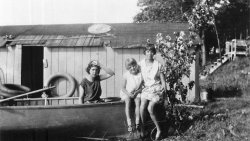
- The Sportsmen: 1905
- ... Range'; not sure why.
We're gonna need a bigger boat Da-dum. Da-dum. Da-dum. Da-dum-da-dum-da-dum.
I love me some nature ... dead.
The "canoe" is an Adirondack Guide Boat. Note the rowlocks. Built light so the guide could carry it and big so ... Posted by Dave - 08/21/2012 - 12:37pm -
![The Sportsmen: 1905 Upstate New York circa 1905. "Hunting in the Adirondacks." When deer and canoe collide. 8x10 inch glass negative, Detroit Publishing Co. View full size.
What a day!Shot a deer and my friend found this nifty canoe in the woods!
PoseursThat deer looks stuffed. I think this is a photo shoot for postcards.
[Just about every one of the hundreds of Detroit Publishing images seen here was a photo shoot for postcards. I don't know about "stuffed," but the deer seems to have been gutted. - Dave]
Bambi's Father?Are you proud of yourself, shooting an unarmed deer? His wife and kids will wonder why he isn't coming home tonight. I am being facetious; I really do get both sides of the argument and these men probably needed this deer to feed their families, but I never got over the tragedy that befell Bambi's mother. Still, that guy with the rifle does look rather villainous (and the deer meant no harm). To borrow and paraphrase a James Dean line "Shorpy, You're tearing me apart!"
[Something tells me these Abercrombie-outfitted sportsmen did not need venison to feed their families. - Dave]
CuriousThe line "when deer and canoe collide" made me start humming 'Home on the Range'; not sure why.
We're gonna need a bigger boatDa-dum. Da-dum. Da-dum. Da-dum-da-dum-da-dum.
I love me some natureThat deer is resting so peacefully. I would think that he would be a bit unnerved with that guy standing so close, let alone holding a gun. It's as if he's saying "don't mess with this deer... let him sleep!"
Is it true that this is part of a series of shots where one man holds a rifle while the other carries large objects above his head, unassisted? Next up... "Where ya want ya cabin mister?"
Look into my eyesI was given the advise that a deer with its eyes closed is alive and you should not go near it. Open eyes means it's dead.
The "canoe"is an Adirondack Guide Boat. Note the rowlocks. Built light so the guide could carry it and big so the "sport" could bring home the bacon, er, venison. Among the most efficient rowing boats ever built they're a joy to row. They move nicely with each pull and track straight in the water. Very important since the boat was usually the only practical way of getting home. The hull planking is very thin for the size of the boat and they were traditionally fastened with hand-set copper rivets.
Search the name, you'll find that they came in a variety of individual designs, but all sharing the general shape including the wide beam for the gear & game.
Small boat lovers build them today, just like this one and for the price of a slightly used Hyundai you can have one professionally built.
Oar locks?Gee after fifty years I finally get what granny though was so funny:
I can row a boat canoe?
Interesting sequence hereThis deer has already been gutted, obviously washed, allowed time to dry, sewn shut ... and placed on the ground for a photo opportunity?
[These are not candid snapshots -- the Detroit Publishing pictures were taken by professional photographers with giant-format view cameras for sale as colorized postcards and art prints. - Dave]
On a lighter note...Man with Gun: "Aww, man, be careful, you knocked him out with that thing!"
Man with canoe hat: "Well, geez, with those horns I thiught he was gonna gore you!"
"Norwegian Blue"That deer is NOT dead!
No, no, 'e's uh,...he's resting.
No, no.....No, 'e's stunned!
Well, he's...he's, ah...probably pining for the fjords.
Great pictureThis is a great picture. I am a hunter. An animal that is consumed is killed whether it is shot in the wild or killed prior to slaughter. A person who consumes products made from animals is as much the cause of the death of an animal as the person who pulled the trigger. There are more deer roaming the US now than when these fellows were alive.
Not A SportUntil the deer is armed too.
Speeding canoesThis is what happens when you speed while portaging. It happens all the time! Rangers warn canoeists but no one thinks it will happen to them. This guy is lucky. He's not wearing his seat belt.
DeliveranceThat's lunch sorted. Now, where's that banjo music coming from?
(The Gallery, Boats & Bridges, DPC)](https://www.shorpy.com/files/images/4a17145a.thumbnail.jpg)
- F5L Flying Boat: 1921
- 1921 or 1922. "Aeroplane exhibit, museum." For a closeup of the sign click here . National Photo Company Collection glass negative. View full size.
(The Gallery, Aviation, D.C., Natl Photo) ... Posted by Dave - 09/11/2011 - 7:29pm -
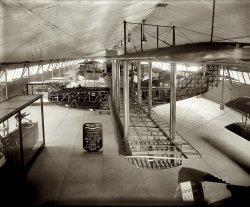
- Boy, Bike, Boat: 1906
- The Detroit River circa 1906. Steamer Tashmoo at St. Clair Flats, Michigan." 8x10 inch dry plate glass negative, Detroit Publishing Company. View full size.
What was he thinking? When enlarging these pictures, I often find it riveti ... Posted by Dave - 10/08/2014 - 6:11pm -
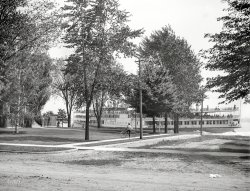
- Sternwheel Tow Boat Ironsides: c.1910
- The Pittsburgh Sternwheel Tow Boat "Ironsides" was built in Pittsburgh, Pennsylvania in 1869 and was in ... Posted by D_Chadwick - 08/29/2017 - 7:18am -
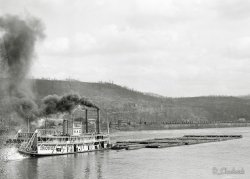
- The Glass Bottom Boat: 1958
- A ride on a glass-bottom boat, Silver Springs State Park, Florida, 1958. I'm on the right sitting ... Posted by ChuckB - 01/16/2018 - 10:05am -
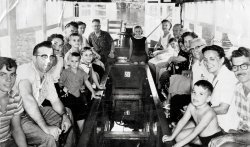
- Party Boat, US Navy in China: c. 1946
- This is a group shot that appears to have been taken aboard ship. This is China, c. 1946. Grandpa was stationed in China as a U.S. Army Captain. Grandma is the Chinese lady seated in the lower right. The Chinese Nationalist officer seated in the ... Posted by citybeautiful - 09/19/2011 - 9:56pm -
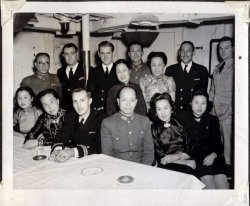
- Float Your Boat: 1905
- June 24, 1905. "Steamer William E. Corey, the launch, South Chicago, Ill." Seen earlier here and here . 8x10 inch dry plate glass negative. View full size.
Lean WAY back! Looks like the tug in the foreground has a funnel that ... Posted by Dave - 09/24/2018 - 11:08am -
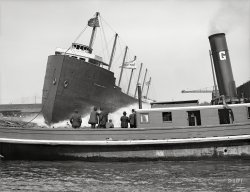
- Banana Boat: 1906 (Colorized)
- From original Shorpy image. This was quite a challenge for me to do; so many small images of men on the dock, so few color varieties. Someone commented that the ship partially shown on the right, the Disa, was sunk during WWI with, fortunately ... Posted by friedadventures - 06/08/2012 - 10:21pm -
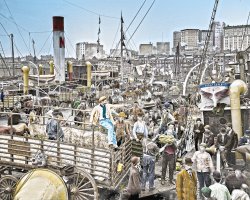
- The Boat Crush: 1904
- Eights Week, 1904, Oxford. One of a series of images taken in Europe in 1904 by an unknown photographer. Scanned from the nitrocellulose negative. Spectators jockey for good viewing positions in anticipation of the sculling races. The large houseb ... Posted by billinmn - 09/21/2011 - 12:12am -
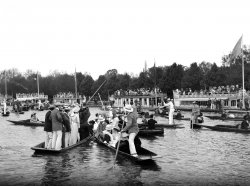
- Curtiss HS Flying Boat - c.1917 #1
- These were in use by the military between 1909 and 1919. Scanned from the original negative. View full size.
(ShorpyBlog, Member Gallery) ... Posted by D_Chadwick - 09/21/2011 - 11:38pm -
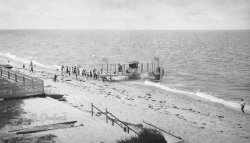
- Whitefish Bay: 1904
- ... They are simply a joy to row.
Who owns this boat? I think the man pushing the boat is the owner of this boat. He is also a married man according to the ring ... Posted by Dave - 06/03/2020 - 2:31pm -
![Whitefish Bay: 1904 1904. "Off for a fishing trip. Whitefish Bay, Ontario." 8x10 inch dry plate glass negative, Detroit Photographic Company. View full size.
Masculine felicityEverything in this photo screams manliness from the hats, to the pipes, to the fishing gear, to those field boots that I want really badly.
Timeless ClassicThe fishing vessel seen here appears to be an example of -- or at least a close approximation of -- the ubiquitous 19th-century Whitehall pulling boats once commonly seen in taxi or delivery service in every North American or English harbor. Still offered today by numerous specialty builders in various lengths, Whitehalls have never been surpassed in terms of combining seaworthiness, speed, dryness, and fine manners in all conditions. They are simply a joy to row.
Who owns this boat? I think the man pushing the boat is the owner of this boat. He is also a married man according to the ring on his left hand. His partner must be single {no ring) and is too relaxed for this to be his boat. He does not seem too concerned about this boat being launched from these rough rocks.
LL BeanAt first, I thought this was a painting. It looks for all the world like the cover to an LL Bean catalog.
Whitefish Bay The Edmund Fitzgerald almost made it there back in '75.
"The searchers all say they'd have made Whitefish Bay
If they'd put fifteen more miles behind 'er"
Wrong Whitefish BayIn response to WM Dyer, the Edmund Fitzgerald and the song by Gordon Lightfoot refer to Whitefish Bay, Michigan, not Ontario. That said, its still a great song!
RibsLook at the rib count. Built like an LL Bean canoe before Fiberglas.
That backgroundis exactly what the famous Canadian artist Tom Thompson would paint. And he may have.
Is that you, Homer?Has all the feeling of a Winslow Homer painting.
Whitefish Bay Michigan/OntarioFrom my knowledge Whitefish Bay is found at the east end of Lake Superior, and borders both Ontario and Michigan.
LJD56, are you saying this in a different location in Ontario? I did find a small hamlet on Google Maps near Lake of the Woods, on a Reserve by that name.
Here is a link to what I have always known as Whitefish Bay.
https://goo.gl/maps/C66DXrgsLq8Nhoau9
MissinaibiI think this might be Whitefish Bay on Missinaibi Lake in Ontario ...
[Detroit Photographic's other 1904 views of Whitefish Bay were taken from Mount Arabella and include McGregor Bay. So this particular Whitefish Bay is in the northern reaches of Lake Huron. - Dave]
(The Gallery, Boats & Bridges, DPC)](https://www.shorpy.com/files/images/SHORPY-4a12064a1.thumbnail.jpg)
- Curtiss HS Flying Boat - c.1917 #2
- These were in use by the military between 1909 and 1919. Scanned from the original negative. View full size.
(ShorpyBlog, Member Gallery) ... Posted by D_Chadwick - 09/21/2011 - 11:38pm -
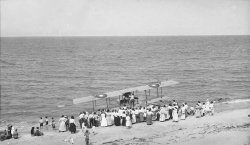
- The Love Boat: 1908
- This is my colorized version of this Shorpy original. View full size.
(Colorized Photos) ... Posted by SirCarl - 09/30/2017 - 11:25am -
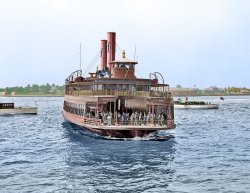
- Banana Boat
- Bananas on the dock, Pacific side of South America, 1940. View full size.
(ShorpyBlog, Member Gallery) ... Posted by chiliangel - 01/13/2012 - 9:44am -
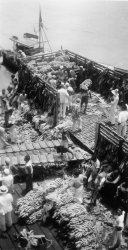
- Smart S Rowers: 1912
- ... "Stanford University varsity crew at Poughkeepsie, N.Y., boat house." Capt. Seward, second from left. 5x7 glass negative. View full ... time to travel for a competition!
The Boys in the Boat California schools had a long-running crew rivalry with eastern ... Posted by Dave - 10/04/2016 - 1:00pm -
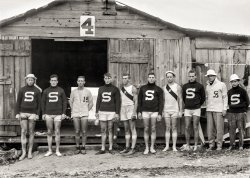
- Brooklyn Bridge: 1905
- ... - Dave]
Style! What a beautiful, elegant looking boat!
Boat Ride It looks like it could be a very pleasant boat ride up the Sound ... Posted by Dave - 07/31/2012 - 2:53pm -
![Brooklyn Bridge: 1905 New York circa 1905. "Brooklyn Bridge over East River." 8x10 inch dry plate glass negative, Detroit Publishing Company. View full size.
Chester W, ChapinThis steamer was named for Chester W. Chapin (December 16, 1798 – June 10, 1883), U.S. Representative from Massachusetts (March 4, 1875-March 3, 1877). The ship was of the twin-screw type, 312 feet in length, 64 feet wide, with a tonnage of 1,882. It was built by the Maryland Steel Company of Sparrow's Point, Maryland, for the New Haven Steamboat Company in 1899.
NoticeThe piles of ballast stones near the bottom of the photo, as well as the railcar float to the left of Pier 20.
Nice Looking BridgeIs it for sale?
Wow. I can almost smell it, man. Nice job once again.
Fab Photo!What a great photo! I love to visit New York, and every time I do, I go to Brooklyn and I walk across the Brooklyn Bridge to Manhattan. I am always amazed at t his amazing structure and this is a wonderful photo!
Roll Out The Barrell(s)Nice photo. The "Chester W. Chapin" looks like a nice craft to take a ride up L. I. Sound on. It's rare to see a staved barrell these days. There sure are a lot piled up there on the dock.
[Evidently they were full of L's. - Dave]
Style!What a beautiful, elegant looking boat!
Boat RideIt looks like it could be a very pleasant boat ride up the Sound to New Haven or Bridgeport.
New?What an immaculate-looking ship is the "Chester W. Chapin!" Quick, let's invent the term "shipshape."
Uh-OhThe Chester W. Chapin was a passenger and freight steamer that ran aground up in Providence in 1901.
http://query.nytimes.com/gst/abstract.html?res=9403E2D61330E132A25756C0A...
High tideThere appears to be a high water mark on the sides of this building.
(The Gallery, Boats & Bridges, DPC, NYC)](https://www.shorpy.com/files/images/4a12689a.thumbnail.jpg)
- Penn Varsity: 1914
- ... photo is almost a hundred years old.
The Boys, the Boat & the Book Though taken 20 years earlier, this image reminds me of ... and inspiring books I've read recently, The Boys in the Boat, which is about the hardscrabble group of young men who comprised the 1936 ... Posted by Dave - 04/14/2022 - 1:18pm -
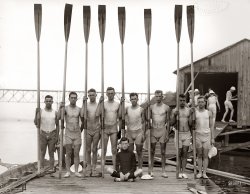
- First Across: 1919
- ... — N.Y. Times
May 1919. "The NC-4 Curtiss flying boat, designed by Glenn Curtiss, at Rockaway Beach, Long Island, New York. The ... No wonder it took so long. No Propellers!
Flying Boat Technically, the NC-4 was a flying boat, not a seaplane. Seaplanes were ... Posted by Dave - 05/10/2019 - 2:19pm -
![First Across: 1919 100 years ago saw the first trans-Atlantic flight, and it wasn’t Lindbergh’s. A giant Navy seaplane flew from Queens to the Azores in 1919, eight years before the Spirit of St. Louis. It took three weeks. It wasn’t nonstop. — N.Y. Times
May 1919. "The NC-4 Curtiss flying boat, designed by Glenn Curtiss, at Rockaway Beach, Long Island, New York. The NC-4 was the first aircraft to cross the Atlantic Ocean as part of the U.S. Navy transatlantic flight attempt." 5x7 glass negative, Bain News Service. View full size.
Three weeksNo wonder it took so long. No Propellers!
Flying BoatTechnically, the NC-4 was a flying boat, not a seaplane. Seaplanes were aircraft that could take to the water by having floats fitted in place of wheeled undercarriages.
Seaplanes for a reasonAll early transport planes were seaplanes. The reason is that there were few reliable methods of overland navigation, no airstrips suitable for landing a plane, and no accommodation for either passengers or aircraft inland. Seaports and coastal routes were long established.
These big Navy seaplanes with "Putty" Read & five-man crew did what they could to go from Rockaway Beach - Chatham - Trepassey - Azores - Portugal - France - England. Much of it in bad weather in exposed cockpits.
Pilot was first U.S. Coast Guard airmanHe had quite the vision to understand the future of flight in its infancy.
https://en.wikipedia.org/wiki/Elmer_Fowler_Stone
ReliabilityLindbergh chose single engine because he couldn't make it with a failed engine on a multiengined plane anyway. It would just double his chances of not making it to have two engines.
A seaplane isn't out of luck with a failed engine over water.
NC-4 Today in PensacolaToday's Pensacola New Journal has this article on the NC-4, which is now housed in the Naval Aviation Museum at the Pensacola Naval Air Station.
Aviation mythsThe vast majority of flying boats (let alone seaplanes) were not designed and built to take down on the open sea. And the vast majority couldn't, accordingly, in anything of a sea swell. The boat part was not risk mitigation, it was the design solution to account for lack of land based infrastructure. As well as saving the weight of a landing gear of limited utility. Plus, Goodyear et al were not quite up yet to making tires that could take the loads associated with (for its time) large aircraft landing gear. After all, we are talking 1919 here. The time when automobiles frequently had two or even more spares, and a full repair kit, and actually needed and used them.
The Spirit of St. Louis used one engine beacause one engine was (barely) enough to get it to Paris. After all, Lindbergh was on a budget. And then as now the engines are easily the most expensive part of an aircraft. And the Wright J-5C Whirlwind was arguably among the most efficient and reliable engines of its time in the first place.
Hull by HerreshoffThe NC-4 hull was built by the celebrated Herreshoff Manufacturing Co. in Bristol, Rhode Island. There is (or was when I last visited) a superb model of the flying boat in the Herreshoff Museum.
UnremarkableAs any school child outside the US knows, British aviators John Alcock and Arthur Brown made the first non-stop transatlantic flight in June 1919. They flew a modified First World War Vickers Vimy bomber from St. John's, Newfoundland, to Clifden, Connemara, County Galway, Ireland. Centennial celebrations are being held in Ireland next month.
There is only ever one first. In this case, crossing the Atlantic by island hopping on a relaxed schedule is not that remarkable.
https://en.m.wikipedia.org/wiki/Transatlantic_flight_of_Alcock_and_Brown
[Newfoundland (an island!) to Ireland (an island!) is only slightly more impressive than Greenland to Iceland. - Dave]
(The Gallery, Aviation, G.G. Bain, NYC)](https://www.shorpy.com/files/images/SHORPY-28703u.thumbnail.jpg)
- Open Sesame: 1907
- ... the Blues Brothers bridge is a different one.
The odd boat I believe that's the top of a mobile caisson used for underwater ... or handkerchief, too, on the side by the strange "turtle boat."
[I think the camera is in the same spot. This photo has been ... Posted by Dave - 08/15/2012 - 3:06pm -
![Open Sesame: 1907 Chicago, Illinois, circa 1907. "Jackknife Bridge, Chicago River." The Pueblo passing through the open span. Glass negative by Hans Behm. View full size.
Sorry no bluesThis is not the Blues Brother Bridge. The river is to narrow and to many buildings. Looking over the 1906 Chicago Public Works report, the direction of shadows and the fact that the train is going over this bridge I suspect that it's the Lake Street bridge over the South Branch of the Chicago River. It's not Wells Street because that bridge goes north south. Problem is the Lake Street bridge had pavement added in 1907 & this one does not.
[The photo could have been made after 1907. - Dave]
More, info found. Lake St carried traffic and was paved in 1901. So no Lake St. This is an elevated track bridge that was located between Van Buren St and Jackson Blvd. It's on the maps of Chicago till sometime in the 50's. This was the one bridge for subway tracfic only in the loop. I found a few refence photos including the builders photos and no refence to location but South Branch of Chicago River. This is a Scherzer Rolling Lift Bridge built in 1895. I love this stuff and this website.
DrawbridgesThis drawbridge is the one at State street at W. Wacker drive. Apparently the Blues Brothers bridge is a different one.
The odd boatI believe that's the top of a mobile caisson used for underwater maintenance in those days.
Jackknife Bridge, Chicago RiverThis is probably the Lake Street bridge, which was replaced by a double-decker bridge a few years a few years after this photo. It looks like this today.
He moved the cameraMust have moved it a good seven or eight feet closer to the bridge. Interesting that something happened to the white napkin or handkerchief, too, on the side by the strange "turtle boat."
[I think the camera is in the same spot. This photo has been cropped. - Dave]
Pueblo of MilwaukeeI'd love to know more about the "Pueblo." It appears to be an old wooden-hulled sailing ship that has been converted to steam.
BatteredLooks like the Pueblo has had her share of bumps and bruises. Neat picture
We all live ...I recognize the boat in the foreground.
Pueblo (1891-1937)The Pueblo was built by the Milwaukee Shipyard in 1891. Renamed the Richard W in 1916 and finally the Palmbay in 1923. On Jan 16, 1926, she burned at her winter layup dock. Thought to be salvagable, but finally scuttled in Lake Ontario in 1937 without repair.
Jake and Elwood, where are you?Isn't this the bridge shown in "The Blues Brothers"?
Van Buren Street BridgeFrom the Chicago Postcard Museum.
Correction. This is not the Van Buren St Bridge but a bridge between Van Buren St and Jackson that is no longer there.
(The Gallery, Boats & Bridges, Chicago, DPC, Railroads)](https://www.shorpy.com/files/images/4a22367a.thumbnail.jpg)
- Boston Bridges: 1904
- ... scheduled. That will account for the fact that the small boat passing under these spans appeared to have sufficient clearance without ... is much safer when one rail is longer than the other.
Boat Too bad we can't see more of the boat other than the 'scape pipes and ... Posted by Dave - 08/03/2012 - 3:04pm -
![Boston Bridges: 1904 "Tower bridges, Fort Point Channel, Boston, 1904." Spans for Northern Avenue, Congress Street and Summer Street. Detroit Publishing Co. View full size.
Bascule bridgesThe photo seems to have been mislabled as these bascule bridges are clearly not for vehicle traffic, but rather for rail use. The ties as well as guard rails that are parallel to interior of the running rails are clearly visible. Normally, the counterbalance weights on bascule bridges are suspended above the vehicle roadway, but given the vertical clearance required for early 20th century rail traffic, these weights have been arrayed outboard of the trusswork. Operationally, most rail bridges like these are left in an open position and closed only when rail traffic is scheduled. That will account for the fact that the small boat passing under these spans appeared to have sufficient clearance without the necessity of having to raise the spans. Finally, it is very common for rail bascule bridges to have their far end angled as these have been. The reason being that track alignment is much safer when one rail is longer than the other.
BoatToo bad we can't see more of the boat other than the 'scape pipes and stack and possibly the name board. What was the name or is it too fuzzy to read?
[Valora. - Dave]
O&W GuyIt doesn't say anything about R/R or vehicle traffic. I fished off these bridges as a boy and they were used for both.
Swinging BridgeThe Northern Avenue swing bridge was built in 1908, and still stands today.
A 1925 picture:
http://www.curp.neu.edu/sitearchive/spotlight.asp?id=2388
Were these bridges located between the current Congress and Summer St bridges?
Those bridges now...Look like this:
http://flickr.com/photos/hargadon/312333298/
Fort Point Channel bridgesI love this picture. Such wonderful shapes up against a featureless sky. I'm pretty certain, however, that these bridges aren't the Summer St, Congress St, and Northern Avenue bridges. I work in the Fort Point district and walk across the Summer Street bridge twice a day (the wind across that bridge is incredible, by the way. Whips right through you.)
A view of the channel today shows Summer, Congress and Northern quite far apart from each other (Seaport Boulevard is a brand-new bridge and was built after the Northern Ave swing bridge was fixed in place.) Only the Congress Street bridge is a bascule, and the Summer Street bridge is a unique retractile bridge, in that both of its spans used to slide out diagonally on narrow-gauge railroad tracks (which you can see on the left-hand side of the bridge.) None of these bridges are operating; in fact, the city is in the process of renovating the Congress Street bridge and just in the past year took out the gigantic concrete counterweights which used to hang above the roadway. Always got the heebie-jeebies walking under that thing.
I'm willing to bet these three bridges were located further south down the channel, and probably served the South Station train yards (I see quite a deal of boxcars in the distance.) In fact, I bet one of these bridges now serves as that piece of public art linked up in the first comment. I've seen it before and know that it was from a bascule that existed at that very spot before the Big Dig and the changes to the area.
At any rate, no matter where these bridges existed, they looked wonderful when they did.
South StationThese are Scherzer Rolling Lift RR bridges at the approach to South Station, Boston. The advantage of the Scherzer is that it rolled back away from the channel to provide unlimited overhead clearance ("air draft").
Note the oversize gear teeth in the rollers + supporting track to keep them aligned as they rolled.
It appears they were raised all the way here just for the photographer, as indicated by the executive looking guy.
Search for "The Mechanical Equipment of the New South Station, Boston, Mass" in Google Books (the actual URL is way too long), scroll down to page 482.
Fort Point Channel BridgeThat is a gorgeous photo of the Old Colony Fort Point Channel Bridge! I've never seen a picture before of how it was when it was functional. Here is how I remember it, how it looked before it was torn down to make way for the Big Dig:
http://flickr.com/photos/30368028@N05/2990743942/
(The Gallery, Boats & Bridges, Boston, DPC)](https://www.shorpy.com/files/images/4a11410u.thumbnail.jpg)
- Product Launch: 1905
- ...
[Steeped in history! - Dave]
This Detroit boat looks so modern Just I wanted to write. Very modern boat as almost 110 years old. Very streamlined.
Happy Days Q: What are ... Posted by Dave - 12/05/2014 - 12:12pm -
![Product Launch: 1905 Circa 1905. "Launching of the Detroit (Detroit Yacht Club)." 8x10 inch glass negative by Lycurgus S. Glover, Detroit Publishing Co. View full size.
A ChampionIn August of 1905 the yacht Detroit won the Lipton Cup in San Diego.
[Steeped in history! - Dave]
This Detroit boat looks so modernJust I wanted to write. Very modern boat as almost 110 years old. Very streamlined.
Happy DaysQ: What are the two happiest days of a sailing man's life?
A: The day he buys his own boat and the day he sells it.
The precise date of this photograph isJune 4, 1901, and shows the launching of the Detroit at the yard of the Michigan Yacht & Power Company, situated just south of Jefferson Avenue on the Detroit River just east of downtown. The boat had been commissioned by a Detroit syndicate headed by Alex McLeod, shipowner, former newspaper editor, founder of the Detroit Telephone Company, and Commodore of the Detroit Yacht Club. The vessel was intended to compete for the Canada's Cup races at Chicago, but failed to qualify, losing to another Detroit boat, the Cadillac. It was sold in Spring 1904 to a San Diego syndicate, sent west by rail, underwent some modifications, and, as already indicated here, quickly became one of the premier racing yachts on the Pacific coast, but for only a brief time, as her design and ownership raised questions among Southern California's racing elite and she was banished from racing by 1906.
(The Gallery, Boats & Bridges, Detroit Photos, DPC)](https://www.shorpy.com/files/images/SHORPY-4a14844a.thumbnail.jpg)
- America: 1910
- ... never to be seen again. View full size.
Flying Boat Wow, nothing more than a boat attached to a balloon!
Otherworldly An eerie sight. Great ... Posted by Dave - 04/12/2009 - 2:43pm -
![America: 1910 Oct. 15, 1910. "Wellman airship seen from Trent." Walter Wellman's hydrogen dirigible America just before being abandoned by its crew near Bermuda, 1,370 miles into an attempt to cross the Atlantic from New Jersey. Its engines having failed, the America drifted out of sight, never to be seen again. View full size.
Flying BoatWow, nothing more than a boat attached to a balloon!
OtherworldlyAn eerie sight. Great composition with the ship's railing, horizon line, and airship profile forming a series of parallel lines.
EerieThis seems like one of those once in a lifetime images. having never seen a dirigible in my lifetime, i'd always seen them as elements of science fiction stories.
Line in the waterWhat is that line of waves that seems to be going from the ship to the dirigible? Some sort of tether or anchor to allow the passengers to evacuate?
[I'd say it's a dirigible anchor. If there is such a thing. - Dave]
Airship EquilibratorIf my airship history serves me correctly, what you see hanging below the airship in the water is a device Wellman called an "equilibrator" ... This was a set of metal cylinders tied together and hung beneath the crew cabin, designed to keep the airship at a constant altitude (around 200 ft) and act as ballast. Unfortunately, neither the equilibrator nor the ship itself worked very well, resulting in the crew having to abandon the airship as seen here. Fascinating photo!
[Click here for more on Walter Wellman and his flying kitten. - Dave]
Gone foreverAll I can think of is the Bermuda Triangle. This is one strangely unsettling shot.
Airship historyThaddeus Lowe was the first to make a huge balloon in an attempt to cross the Atlantic from west to east in about 1859. He failed mainly because he couldn't get enough gas to fill it in a timely manner and also ran out of subscription money. Prevailing winds are favorable for this direction at these latitudes, and with a great deal of luck he might have pulled it off .
Even with an engine out, if this machine could maintain that altitude by scooping enough water ballast to compensate for thermal changes day and night without having to vent hydrogen, perhaps it too might have made the full crossing. Both aeronauts, I see now, were backing up their plans with lifeboats as the crew space.
(The Gallery, G.G. Bain, Zeppelins & Blimps)](https://www.shorpy.com/files/images/08853u.thumbnail.jpg)
- John Quill: 1910
- ... Alabama rivers. Her last trip was in 1928.
The second boat is the _y Staples.
[James T. Staples. - Dave]
Show Boat One can almost hear a rich voice start to sing "Old Man River"
The ... Posted by Dave - 08/14/2012 - 4:28pm -
![John Quill: 1910 Circa 1910. "Sternwheeler John Quill, packet steamer." 8x10 inch dry plate glass negative, Detroit Publishing Company. View full size.
Launched 1907, Destroyed 1928Launched: 1907, Jeffersonville, Ind. by Howard Yard
Destroyed: 1928, Feb., towed from Mobil to Twelve Mile Island on what was termed her last trip.
Area: Mobile, Tombigbee and Alabama Rs.
Owners: built for Capt. John Quill and Moore, Mobile, Ala.
Comments: 1916, June 12, Warrior R., hit rock and sank in 15' of water. LINK
Meet John QuillThe John Quill was built in 1907 at the Howard yards in Jeffersonville, Indiana. She was 168 x 35 feet. Ran for the Quill and Moore line on the Mobile, Tombigbee, and Alabama rivers. Her last trip was in 1928.
The second boat is the _y Staples.
[James T. Staples. - Dave]
Show BoatOne can almost hear a rich voice start to sing "Old Man River"
The John Quillran primarily the Tombigbee and Warrior Rivers in Alabama above Mobile, where this photograph was probably taken. Built by the famous Howard Shipyard at Jeffersonville, Indiana, for her namesake in 1907, she served that stretch of river until towed to Twelve Mile Island on the Mobile River (just northeast of Mobile) and dismantled there in 1928. The other vessel is the Jas. T. Staples, built 1908 at Mobile.
Alabama steamerThe "John Quill" was a common sight on the Mobile, Tombigbee, and Black Warrior Rivers, running north from Mobile to Alabama inland river ports such as Demopolis, Claiborne, and Tuscaloosa. Google it for links to lots of digitally archived photos of the steamboat in its working days.
Tired AlreadyThe John Quill looks pretty tired for only two years of service. Must have led a hard life. Note the interesting struts and tension cables designed to pull the ends up and keep the boat from "hogging" (rising in the middle), which increased drag and reduced fore and aft freeboard. I wonder if those were original or added later.
Jas. T Staples' ghost!Researching to find out why some steamboats have fluted stacks like the Staples in the distance, I came across this:
Visit any university campus in Alabama and someone there will tell you about the resident ghosts. One of the strangest ghost stories is the tale of the Captain Norman Staples. Captain Staples designed and built the most elegant riverboat on Alabama rivers and named the boat after his father, James T. Staples. From the moment of its maiden voyage in 1908, the riverboat James T. Staples was in trouble.
The large riverboat companies at the time were determined to put Captain Staples out of business and succeeded in doing so in 1912. On January 2, 1913, Captain Stapes committed suicide and three days later, his ghost began appearing on the deck of the riverboat. The crew, frightened by his apparition, quit and another crew had to be found. The new crew, although they knew nothing about the former Captain, reported seeing a ghost like man in the boiler room of the ship. Exactly one year, almost to the hour, the boiler of the riverboat blew up, killing the new captain and twenty-five members of the crew. Once the ships sank, local residents reported seeing Captain Staples' ghost standing guard over the graves of his four children in Bladon Springs Cemetery.
Chills up my spine!
(The Gallery, Boats & Bridges, DPC)](https://www.shorpy.com/files/images/4a16143a.thumbnail.jpg)
- Navy Cooks: 1897
- ... and made of a white cloth tape.
The rest of the boat I can see the mast of the USS Oregon from my office. It's a memorial ... Posted by Dave - 08/13/2012 - 10:03pm -
![Navy Cooks: 1897 Circa 1897. "Berth deck cooks, U.S.S. Oregon." 8x10 inch dry plate glass negative by Edward H. Hart, Detroit Publishing Company. View full size.
Eagle, Globe and AnchorAnd there's a Marine among them (perched on the ladder).
A pocketknifehttp://www.spanamwar.com/Americanuniformlanyard.htm
Lanyards were issued to all crewmen along with a single-bladed navy pocketknife, which was generally attached to the end of the lanyard. The other end of the lanyard went around the sailor's next, and could be drawn tight by pulling a "turk's head" knot as tight to the neck as was comfortable. By attaching the knife to the lanyard, the chance of dropping the knife overboard or losing it in some other manner was greatly reduced.
One of the few navymen who did not attach a knife to their lanyard was the boatswain or "bo'sun" who would attach his "pipe" to it. The pipe was a high-pitched whistle-like instrument which was used to issue certain orders.
The lanyard was approximately one yard in length (doubled, and therefore was made from about two yards of material) and made of a white cloth tape.
The rest of the boatI can see the mast of the USS Oregon from my office. It's a memorial in the Waterfront Park in Portland. I've often wondered about the ship, so these photos from her are very gratifying.
Where's a Bos'n when you need him?Ahoy mates, that's a pretty scurvy looking deck. And sticking a blade into the teak!
All I can say is that the Oregon must have been a pretty loose ship. In my Navy days, a ship with a teak deck was kept "Bristol" -- that's squeaky clean to you landlubbers. Holystone, seawater and sand every day. And if you had so much as a nail in your shoe, the Chief Bos'n would have your hide.
Holding the cigIs that a cannoli tube or are you just glad to see me?
Soap classicThe "Gold Dust Twins" is cool. Always heard about this stuff from my Grandmother. She is about the same age as these guys. Now I get to see it. I can take that off the list. Thanks Shorpy.
What's on the end of those lanyards?Besides the scarves (ties?), most of these guys are wearing a lanyard around their necks that ends in their left breast pocket. What's attached?
Fate of the OregonIn a burst of patriotic enthusiasm, the Oregon was partially scrapped at the begining of WWII, for the steel. The hull was used as a barge during the war, and eventually scrapped in the 50's.
Display your toolsNo doubt the gunner's mates had just taken their group picture in front of a stack of shells, and the galley crew felt compelled to display their weapons.
Tough cutsI'd say there were few complaints about the food, but we haven't seen the rest of the crew yet.
Take a PowderBaking or washing? Make sure you get the right one for the job!
Surprised No One Has Mentioned ItGuy with the cigarette: what the heck's with the paper heart cutout on his shirt?
[It's a handkerchief sticking out of his pocket. - Dave]
Navy cookingAnother interesting photo. Every man in the group displays the rate of Seaman Third Class (one stripe on the cuff) except of course the Marine and those who have their cuffs turned up. Not one has the rating badge of a Petty Officer on his upper arm. Wonder who was in charge?
That probably meant that cooking chores for enlisted men were turned over to the lowest rated and newest men. Officers of course had cooks and stewards to handle their food needs. Enlisted men didn't fare so well. The rating of Commissary Steward (enlisted cooks) didn't appear until about 1905.
(The Gallery, Boats & Bridges, DPC, E.H. Hart)](https://www.shorpy.com/files/images/4a14632a.thumbnail.jpg)
- Dragon Slayers: 1897
- ... Jackson. View full size.
Blase The girl in the boat seems more interested in her apple than the beast.
Someone's not ... a baby gator. I sure hope Karma exists.
Girl in boat The girl at eye level with the gator but seemingly a million miles ... Posted by Dave - 05/11/2020 - 4:48pm -
